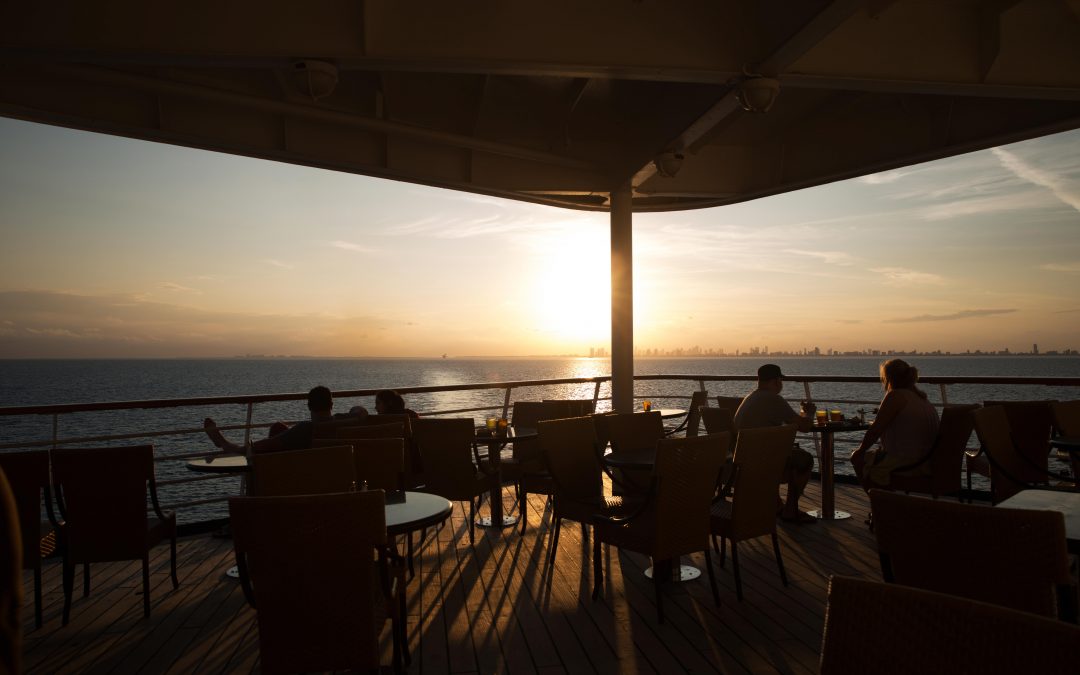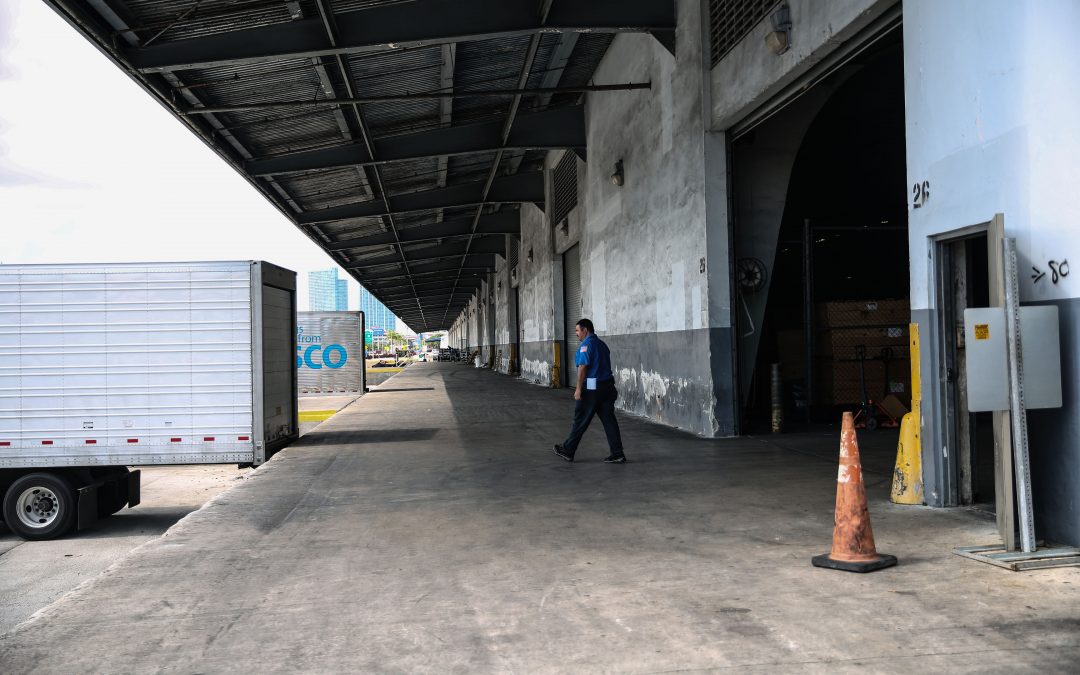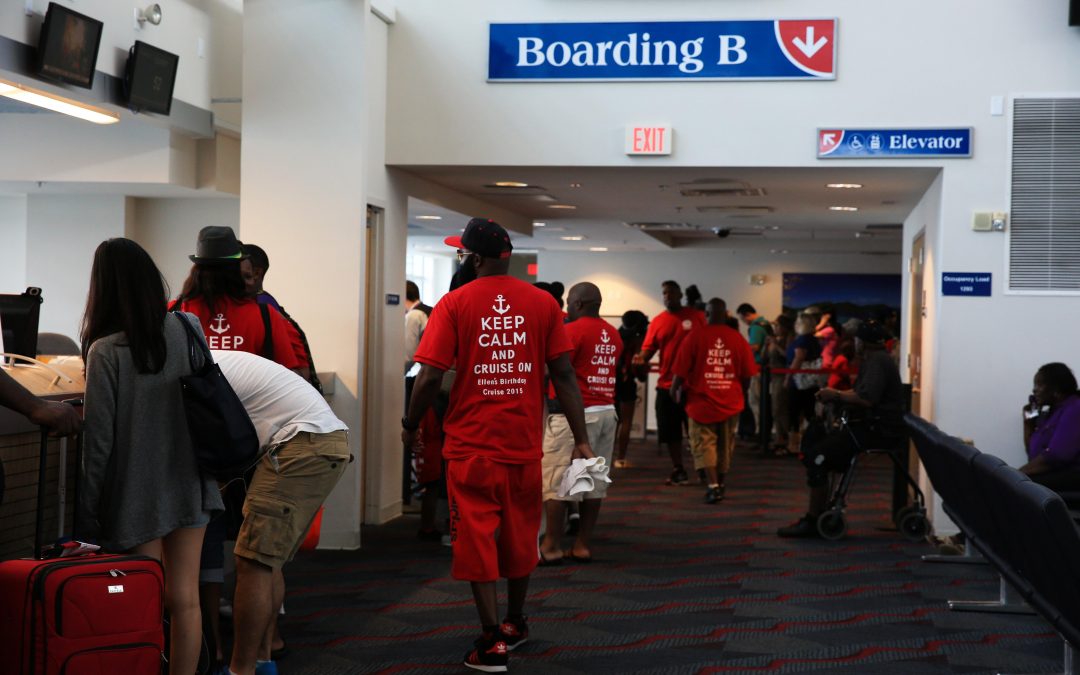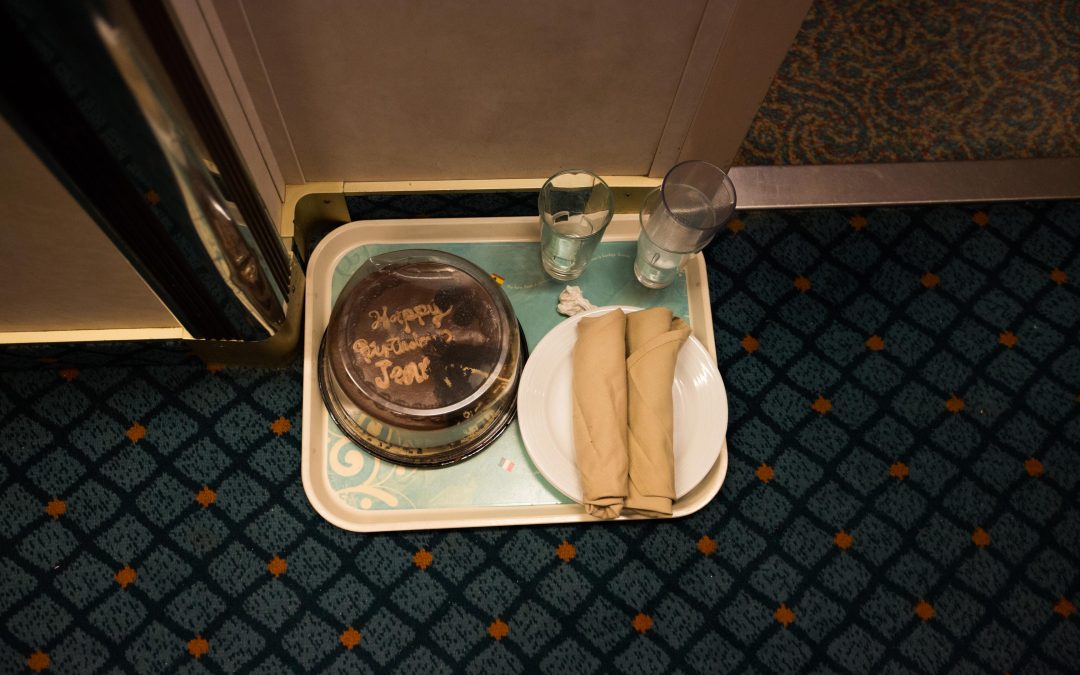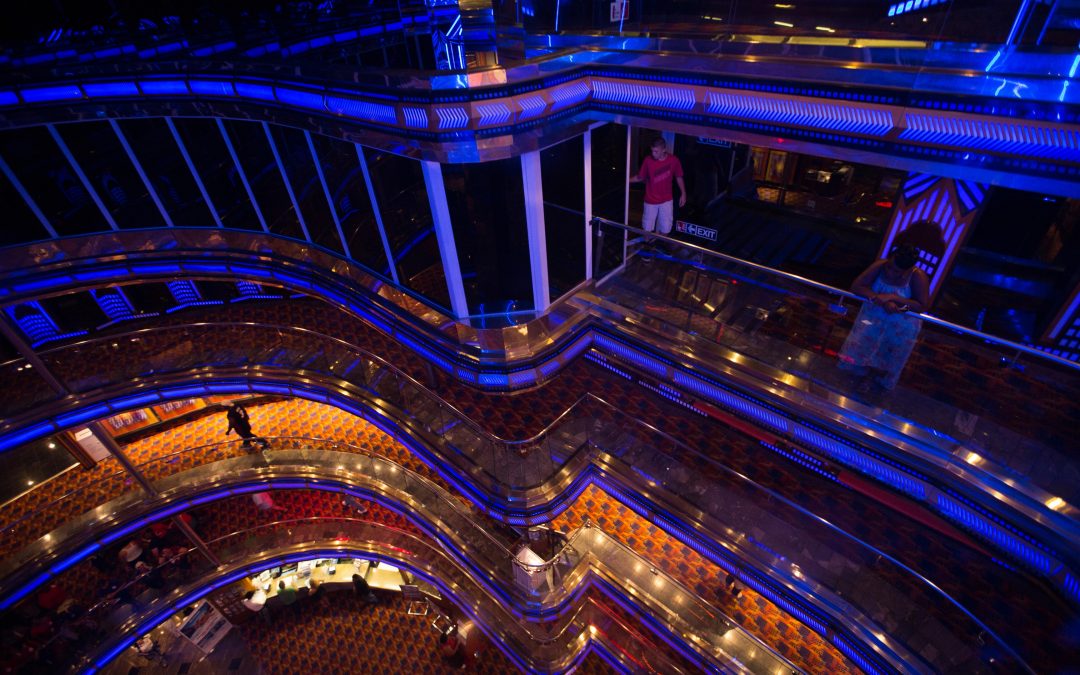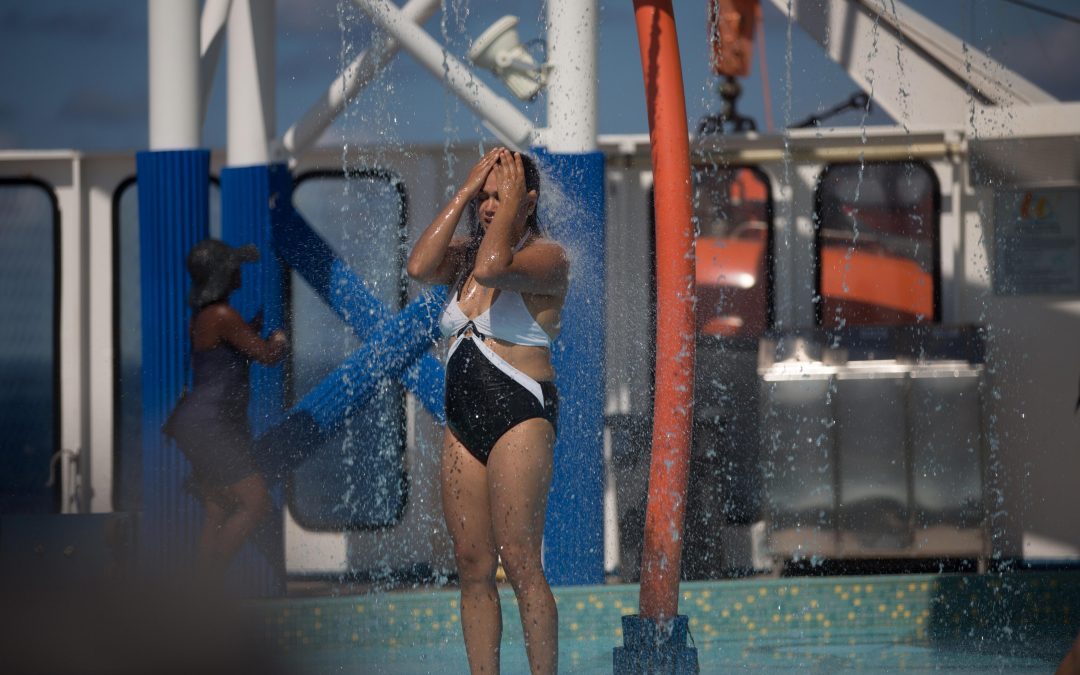It’s estimated that a cruise passenger requires about 8.4 gallons of water a day, which then must be discarded because it’s contaminated by human waste.
A cruise ship majestically floats among glaciers in Alaska. Tourists surrender to the magnitude of the frozen landscape and remain silent before its pristine beauty. But underwater, the scene is quite different.
National Park Service biologist Christine Gabriele has spent many hours of her life using microphones to hear what happens in the depths of Alaska’s Glacier Bay National Park.
In the vast echo chamber that is the ocean, Gabriele discovered something unusual: the humming of machinery coming from cruise ships, in other words floating cities loaded with tourists, can be sensed by whales up to an hour before the ships get there. This noise is deafening to the animals and prevents them from locating and communicating with one another until the ship is long gone.
This scenario in Alaska illustrates how complex it is to evaluate the global environmental impact of the powerful cruise industry, whose reality is often hidden beneath the surface.
None of the three leading cruise companies responded to multiple Univision requests for detailed interviews and comments for this story. Univision was able to talk briefly to two senior executives from Carnival Cruise Line, including CEO Arnold W. Donald, during an event at the Port of Miami in May, but they declined to sit down for longer interviews.
A study from Columbia University School of Journalism identified 768 cruise-ship vessels operating between March 1998 and July 2015. Currently, 265 of them run almost every day of the year and carry an average of 1,200 passengers.
There are even larger ships, such as the Royal Caribbean’s Allure of the Seas, which can carry 5,400 people, enough to fill seven Airbus A380 planes. This ship in particular boasts seven different “neighborhoods” and 2,384 crewmembers on board.
In the Columbia study, 3,628 deficiencies were recorded on cruise vessels; 233 of them were environmental, mostly related to fuel/oil discharges into the ocean (174) and garbage pollution (30).
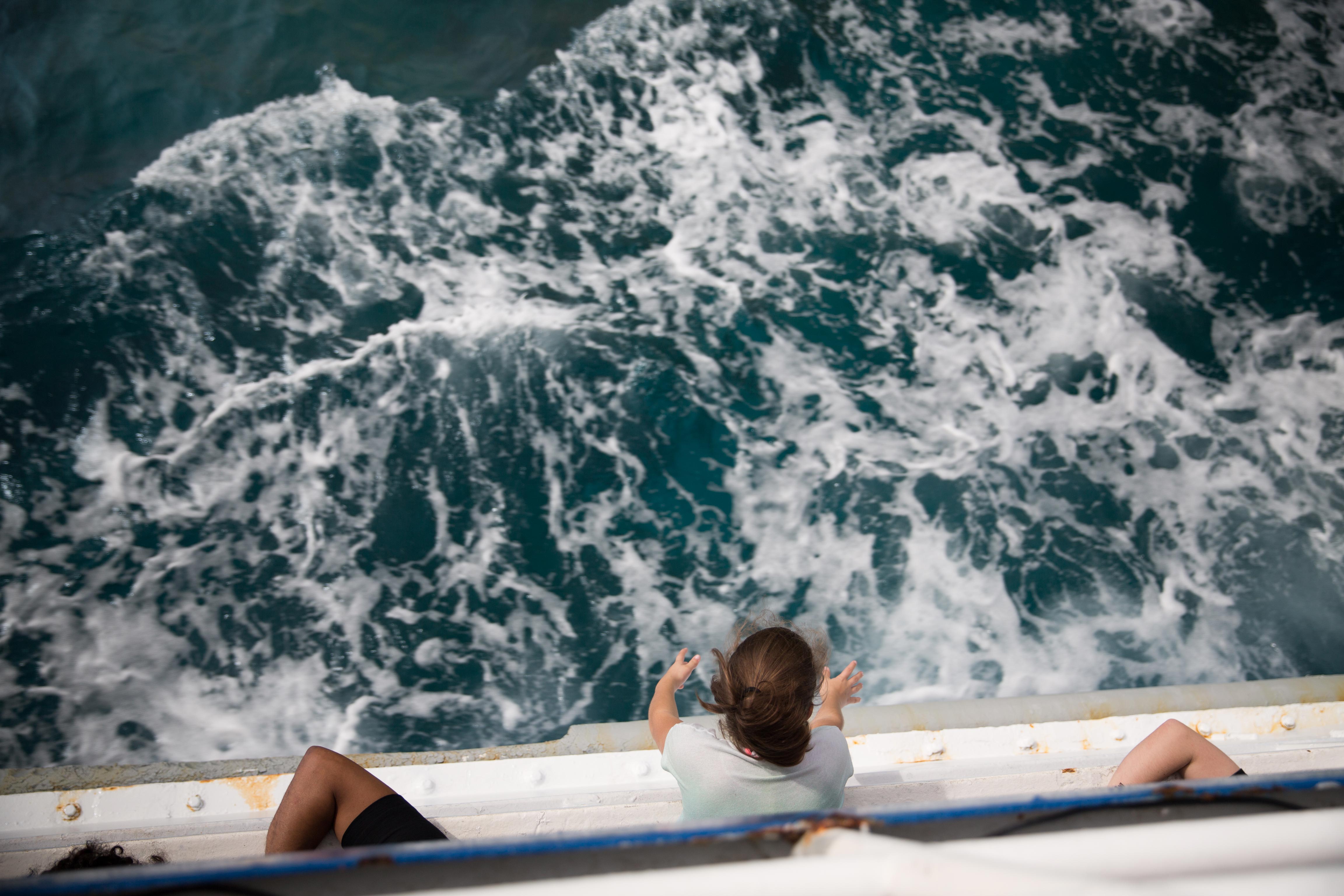
A girl looks over the side of a boat carrying passengers from a Royal Caribbean cruise to a private island of the same company. Almudena Toral/Univision
Of the 233 environmental deficiencies identified in inspections by the Port State Control (PSC) and the United States Coast Guard (USCG), the biggest number came from two ships: the Black Watch and the Coral Princess (12 each).
The Black Watch was built in 1972 and it is owned by a Norwegian company registered in the United Kingdom. The Coral Princess was built in 2002, has the capacity for 2,590 passengers and it is owned by Princess Cruises.
“Well, what cruise ships and other ships have been doing is dumping material that… is not natural. This is not just fresh seawater going back into seawater. This is human waste going into seawater. This is garbage and plastics and metal and soap going into seawater, into the ocean. This is oil and grease and other kinds of things going into the ocean,” says Rep. Sam Farr (D-CA), who on four separate occasions tried to get the U.S. Congress to approve a tough environmental legislation called the Clean Cruise Ship Act. He tried in 2004, 2005, 2008, 2009 and 2013, but failed to get enough support for the measure.
Why was it so difficult to pass the bill? Farr believes that it wasn’t even heard by the committee responsible for voting on it because industry lobbyists blocked it. Cruise companies are reluctant to complying with the same environmental regulations to which land-based hotels are subject, he explains.
The failed attempts of the Clean Cruise Ship Act in the United States came at a time of mounting evidence of the industry’s bad practices, says James Walker, a lawyer who used to defend cruise lines.
“Not even fifteen years ago, ten years ago, Royal Caribbean was caught dumping sewage everywhere. I used to be a defense attorney for the cruise industry. I know firsthand what was happening,” he says.
“I used to be a defense attorney for the cruise industry. I know firsthand what was happening”
Walker describes how trash bags were dutifully piled up in the corridors of the ships’ recycling rooms, but during the night they were dumped into the ocean.
According to the Department of Justice, Royal Caribbean Cruises, Ltd. was convicted in 1998 and 1999 and paid a total of $27 million in fines. The investigation began as a result of a Coast Guard surveillance operation that filmed the Sovereign of the Seas, then the largest cruise ship in the world, discharging oil on its way to San Juan, Puerto Rico.
Ross A. Klein, the author of two books critical of the cruise industry, and who has testified before the U.S. Senate, found that between 1992 and 2015 the media reported at least 317 cases of violations that took place on cruise ships, according to his blog cruisejunkie.com.
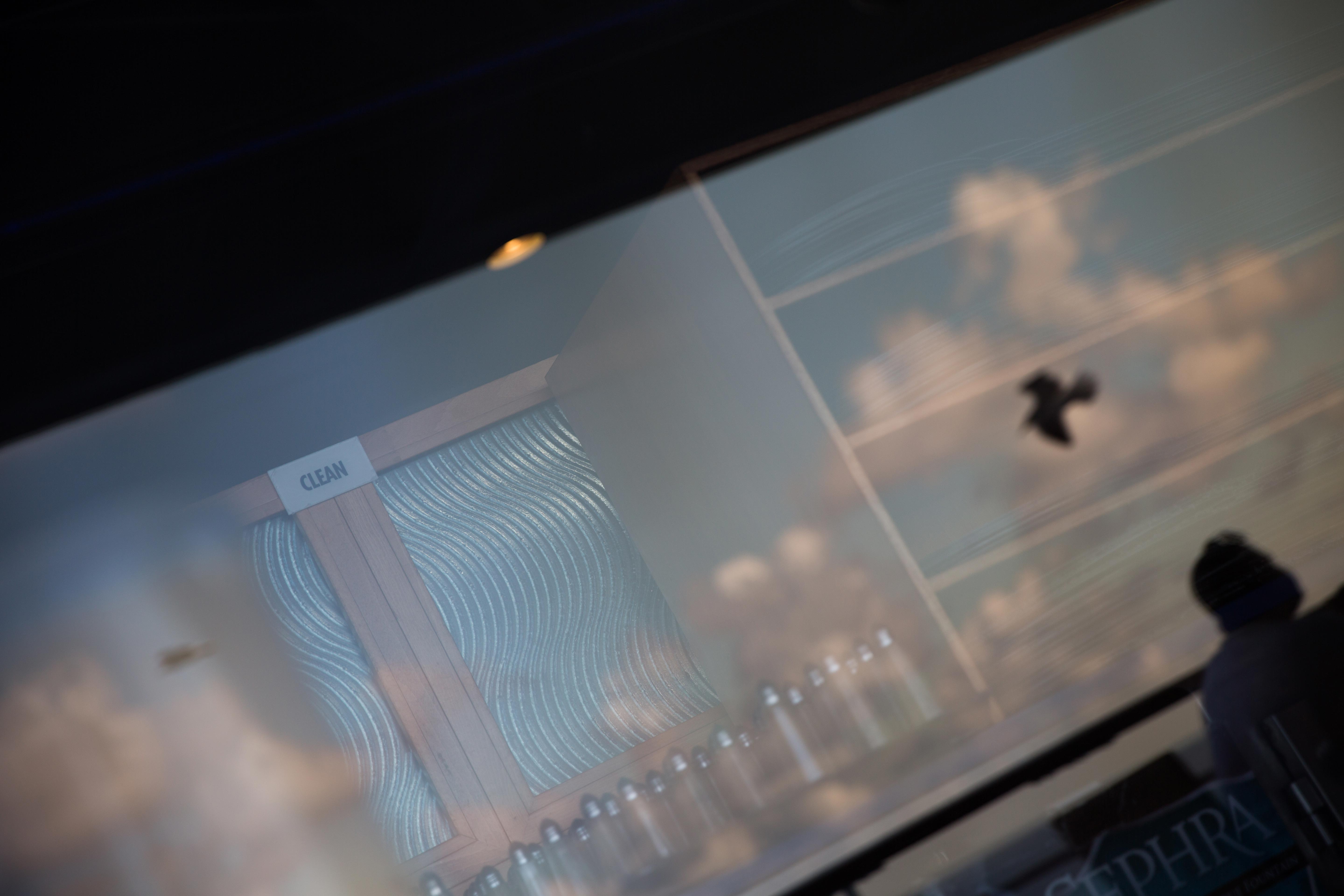
El reflejo de un hombre mientras come en la cubierta de un barco en altamar. De fondo, un área donde los trabajadores del comedor separan platos limpios de sucios. Almudena Toral/Univision
Of those, 130 cases were still pending, most of them from 2008 or after. Among the pending cases, more than 70 are for alleged water pollution and more than 40 are for violations of waste management regulations. There are also around 10 for air pollution.
In more than 44 cases there was either no conviction or the companies were only asked to offer a public apology. Only 120 cases ended in convictions or the companies pleading guilty, according to Klein’s database. This is also reflected in a report from the U.S. General Accounting Office. Penalties can be as low as $250, but they can also amount to millions of dollars.
One example of these cases involving large fines came in April of 2002, when Carnival Corporation pleaded guilty to “numerous occasions from 1996 through 2001 that it discharged oily waste into the sea from their bilges by improperly using pollution prevention equipment.” It was fined $18 million. That same year, Norwegian Cruise Line pleaded guilty to inadequate separation of oil in water discharge and had to pay $1.5 million.
In January 2007, the Dawn Princess was pleaded guilty of traveling over the speed limit in 2001, “hitting and killing a humpback whale.” Its fine was $750,000.
Walker explains these are very high fines because it was proven that the industry was lying to the U.S. government, the Justice Department and the Coast Guard about how it handled waste.
“That’s a fact. It’s a fact that you should consider in deciding whether you want to trust them or not. They have been fined because they have committed and they have pleaded guilty to felonies,” Walker says.
He adds that the cruise ship industry still relies mostly on the use of bunker fuel, a residual fuel that’s cheap and rich in chemicals.
The most recent fine was imposed on MSC Cruises in 2015, according to Cruisejunkie.com. A Brazilian court proved the company was dumping garbage bags overboard, as documented and reported by a passenger on the ship in November 2013. The company had to pay $635,545.
MSC Cruises is the same company that signed an agreement with the prime minister of the Bahamas for a 100-year lease on one of its islands, to establish a private reserve on it. The first trip to the island is slated for December 2017 on a ship weighing 160,000 tons and carrying 5,179 passengers.
As Klein notes in his books, a U.S. Navy vessel currently has to comply with more environmental regulations than a cruise ship. “The reason for the statement is that, in the United States, military vessels must comply with all of the country’s laws (including environmental laws). A foreign-flagged cruise ship, however, is not subject to many of those laws.”
“What you’re doing is you’re using the ocean as a garbage pit, as a sewage pit, and that’s not good for the fish in the ocean, which we catch and eat,” explains Farr, representative of California’s 20th district, from his congressional office in Washington.
Handling the waste
According to Friends of Earth (FOE), “the cruise industry dumps at least one billion gallons of sewage a year into the ocean,” this is enough to fill 1.5 million Olympic swimming pools. It’s estimated that a cruise passenger requires about 8.4 gallons of water a day, which then must be discarded because it’s contaminated by human waste. As the Environmental Protection Agency (EPA) notes, in just one week, a 3,000-passenger boat produces 200,000 gallons of human waste, more than a million gallons of wastewater from bathrooms and dishwashers, and eight tons of solid and toxic waste from washing clothes. Plus, there’s the machinery’s own waste and the burning of fossil fuels.
CLIA Cruise Line Members are already prohibited from discharging untreated sewage or ‘dumping garbage’ in the ocean and implementation of this zero discharge policy is a condition of cruise line membership in CLIA. This prohibition is, in fact, more restrictive than what is allowed under international maritime law.
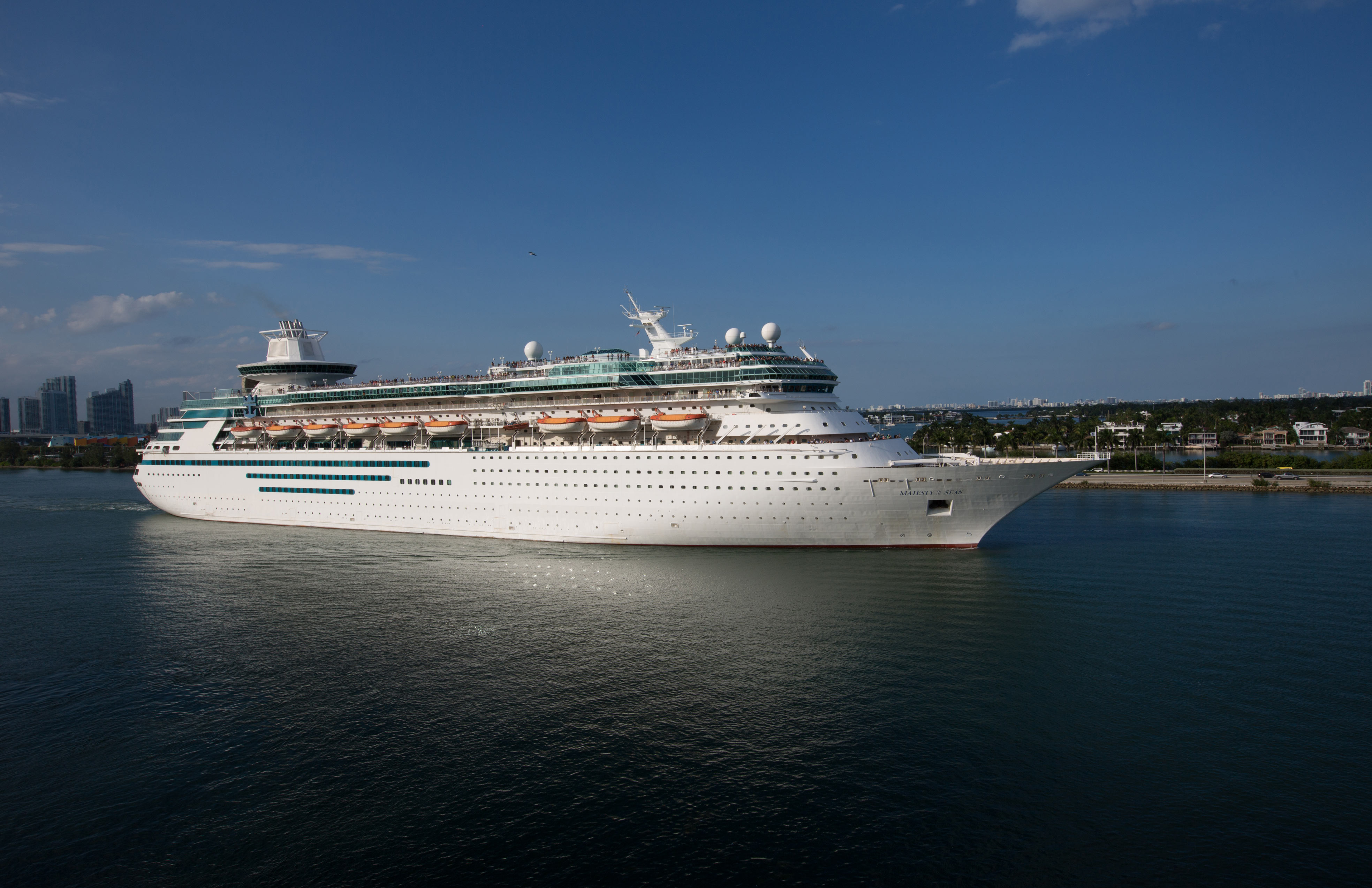
El barco Majesty of the Seas, de Royal Caribbean, saliendo de la ciudad de Miami un viernes por la tarde. Almudena Toral/Univision
Faced with this kind of data, the main cruise companies and the Cruise Lines International Association (CLIA) have defended themselves with more statistics.
For example, Arnold Donald, CEO of Carnival Corp., claims on his official website that the company reduced energy consumption by 25% since 2007. Norwegian says it is accredited by the ISO 14001 international standard for environmental management, and that “the only solid waste discharged in the ocean are food residue considered biodegradable waste.”
Meanwhile, Royal Caribbean pledged in January to reduce 35 percent of CO2 emissions by 2020 and to ensure that the fish served on board come from sustainable fisheries. The World Wildlife Fund (WWF) will certify that this is the case, says project head Sheri Turnbow.
Between 1997 and 2004, WWF received nearly $700,000 from Royal Caribbean to support environmental protection plans. The funds come from the cruise line’s Ocean Fund initiative, created in 1996. It has donated more than $6 million to more than 35 organizations working to protect marine environments, such as the Blue Ocean Institute, Conservation International and The Nature Conservancy.
Science on board
CLIA claims that efforts are being made, and that per mandatory rules, none of its members should ever dump untreated sewage anywhere in the world.
“All CLIA members must verify implementation of industry environmental policies, which often exceed international regulations,” says spokeswoman Elinore Boeke.

Un pasajero del Carnival Ecstasy juega al golf una mañana mientras el barco surca el océano entre Bahamas y Miami. Almudena Toral/Univision
“As should be obvious, protecting and caring for the environment is fundamental to the cruise industry. We depend on healthy oceans, clean beaches and pristine destinations that meet passengers’ expectations today and in the future. Today’s cruise ships are history’s most environmentally friendly maritime vessels. Cruise ship waste management professionals also recycle 60 percent more waste per person than the average person recycles on land each day, recycling 80,000 tons of paper, plastic, glass and aluminum cans each year,” she adds.
Although the CLIA does not keep their own records of the industry’s environmental initiatives, or how much money is invested, the association emphasizes that cruise lines are working regularly with credible ocean researchers from universities and NGOs.
“Scientists do worry and raise their voices about the environmental impact of cruise ships and other non-sustainable activities. This is the reason why the WWF is working with Royal to minimize those impacts as much as possible,” adds WWF researcher Sheri Turnbow.
“Scientists do worry and raise their voices about the environmental impact of cruise ships and other non-sustainable activities. This is the reason why the WWF is working with Royal to minimize those impacts as much as possible.”
One of the most positive scientific benefits of the cruise industry is that it allows researchers to travel for free to remote sites.
“In 2004 we visited the Christmas and Fanning Islands in the central Pacific, and thanks to this expedition we managed to take thousands of samples of coral fossils and were able to prove that the El Niño climate phenomenon was highly variable during the last 7,000 years,” said Turnbow, who is also a paleoclimatologist at the Georgia Institute of Technology. Her research was published in Science in 2013 with a note thanking Norwegian Cruises at the end.
Nevertheless, environmentalists think that consumers should act as watchdogs of the cruise industry.
In 2008 alone, 1,032,074 passengers visited Alaska by cruise ship.
“Cruise companies are advertised as wonderful outdoor experiences where you go out to sea and catch a glimpse of the coastal lines of the world or the navigable rivers in the world. They don’t want you to think that you are riding on a huge septic tank full of sewage and garbage, says Rep. Sam Farr, a Democrat from California.
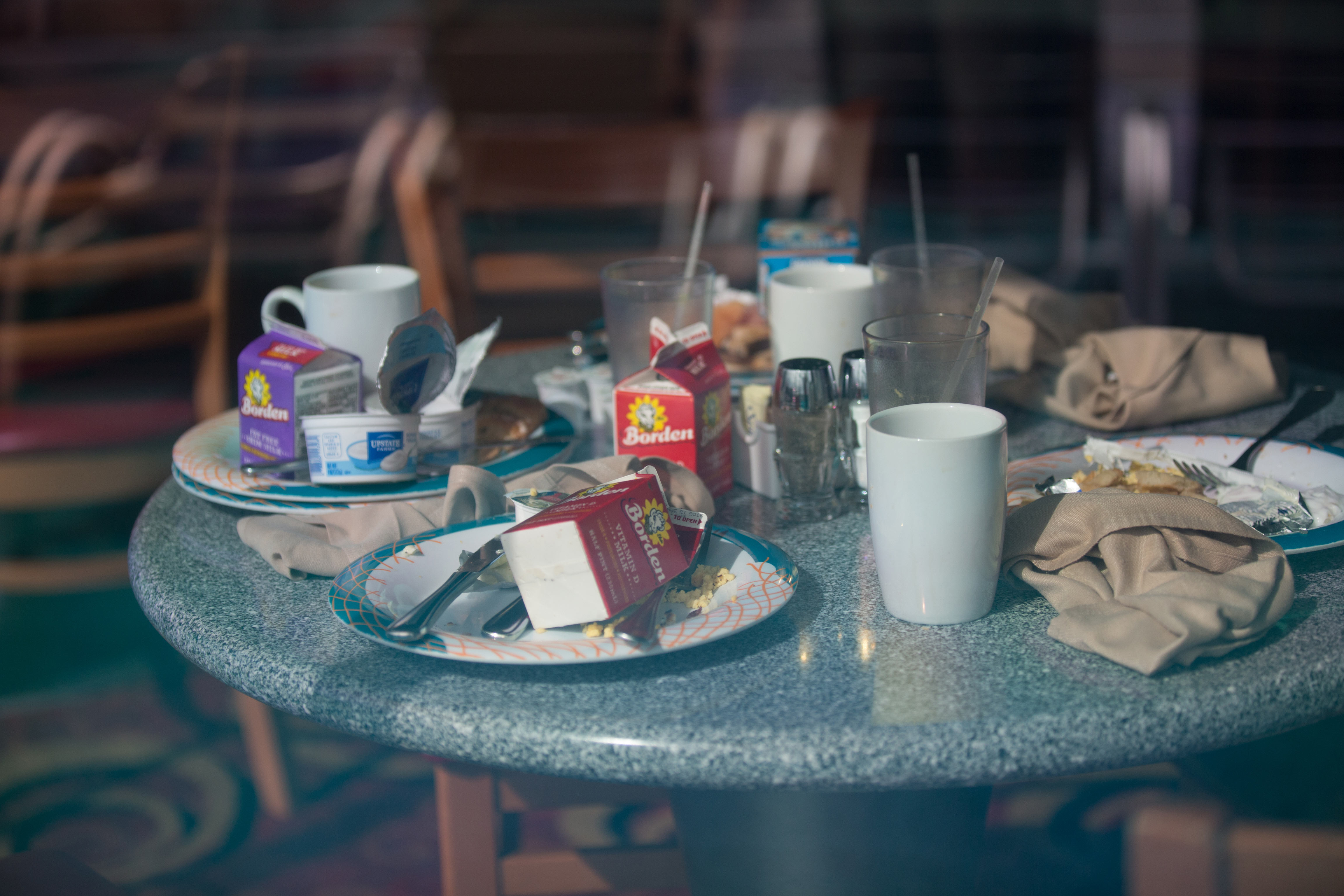
Desperdicios después de un desayuno a bordo del barco Majesty of the Seas, de Royal Caribbean. Royal Caribbean fue condenada en 1998 y 1999 por incumplimientos medioambientales y pagó un total de $27 millones en sanciones penales. Almudena Toral/Univision
“People will continue to take cruises and we cannot avoid that, but we want them to do it more consciously, and to have good information and make smarter decisions. We want people to understand that there are better options,” adds Marcie Keever, director of the ocean and boats program at Friends of the Earth.
According to CLIA’s website, in 2008 alone, 1,032,074 passengers visited Alaska by cruise ship.
A citizens’ initiative succeeded in increasing the cost of getting to Alaska by ship. This consisted of imposing four new taxes, including a $50 tax per person “for new environmental regulations.” This tax was intended to slow down visits.
However, in April 2011, Alaska’s legislature passed a regulation that paved the way for the return of tourist vessels by reducing the tax for cruise passengers from $46 to $34.50. “The reduction of operating costs through the adoption of a more competitive tax structure has been key to Alaska’s growth path,” the CLIA wrote on its website, hailing the decision.
More cruises mean more investments in Alaska’s service economy, but this has not meant more money for research or environmental protection laws.
Keever says that efforts are being made to regulate the operation of cruise ships in Alaska and around the world, but she believes that these “are not significant or enough for the dimension of pollution and alteration of the oceans they cause.”
Cruise companies have been very good at showing their green side, the improvements they have been doing and in many cases that they are abiding by the law, Keever adds. “Therefore what we criticize and what we think is wrong is the law itself, which is weak. We believe the best technology possible must be implemented for use in this industry.
The study on Alaskan whales led by Christine Gabriele between 2000 and 2009 showed the increasing encroachment of underwater noise pollution in Glacier Bay.
“We know that whales are acoustically adept and rely on sound for basic life functions,” she wrote in a 2009 paper published in Alaska Park Science. “Cruise ships are audible (three decibels above natural background noise levels) for 40-74 minutes each time they enter or exit Glacier Bay as measured at the anchored hydrophone in the Lower Bay.”
Audio: This is how cruises sound like underwater.
Since cruise ship speed appears to be the main factor in determining the noise levels to which whales are exposed, Gabriele’s paper advises reducing vessel speed, which also“reduces the probability of whale mortalities resulting from collisions between vessels and whales.”



